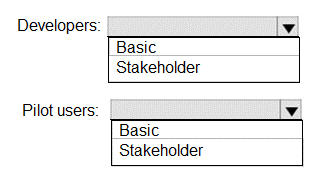- (Exam Topic 4)
Your company is building a new web application.
You plan to collect feedback from pilot users on the features being delivered.
All the pilot users have a corporate computer that has Google Chrome and the Microsoft Test & Feedback extension installed. The pilot users will test the application by using Chrome.
You need to identify which access levels are required to ensure that developers can request and gather feedback from the pilot users. The solution must use the principle of least privilege.
Which access levels m Azure DevOps should you identify? To answer, select the appropriate options in the answer area
NOTE: Each correct selection is worth one point.
Solution:
Box 1: Basic
Assign Basic to users with a TFS CAL, with a Visual Studio Professional subscription, and to users for whom you are paying for Azure Boards & Repos in an organization.
Box 2: Stakeholder
Assign Stakeholders to users with no license or subscriptions who need access to a limited set of features. Note:
You assign users or groups of users to one of the following access levels: Basic: provides access to most features
VS Enterprise: provides access to premium features
Stakeholders: provides partial access, can be assigned to unlimited users for free
References: https://docs.microsoft.com/en-us/azure/devops/organizations/security/access-levels?view=vsts
Does this meet the goal?
Correct Answer:
A
- (Exam Topic 4)
Note: This question is part of a series of questions that present the same scenario. Each question in the series contains a unique solution that might meet the stated goals. Some question sets might have more than one correct solution, while others might not have a correct solution.
After you answer a question in this section, you will NOT be able to return to it. As a result, these questions will not appear in the review screen.
Your company has a project in Azure DevOps for a new web application. You need to ensure that when code is checked in, a build runs automatically.
Solution: From the Pre-deployment conditions settings of the release pipeline, you select After stage. Does this meet the goal?
Correct Answer:
B
Instead, In Visual Designer you enable continuous integration (CI) by:  Select the Triggers tab.
Select the Triggers tab. Enable Continuous integration. References:
Enable Continuous integration. References:
https://docs.microsoft.com/en-us/azure/devops/pipelines/get-started-designer
- (Exam Topic 4)
You plan to deploy a website that will be hosted in two Azure regions.
You need to create an Azure Traffic Manager profile named az40011566895n1-tm in a resource group named RG1lod11566895. The solution must ensure that users will always connect to a copy of the website that is in the same country.
To complete this task, sign in to the Microsoft Azure portal.
Solution:
* 1. Go to the Azure portal, navigate to Traffic Manager profiles and click on the Add button to create a routing profile.
* 2. In the Create Traffic Manager profile, enter, or select these settings:Name: az40011566895n1-tmRouting method: GeographicResource group: RG1lod11566895
Note: Traffic Manager profiles can be configured to use the Geographic routing method so that users are directed to specific endpoints (Azure, External or Nested) based on which geographic location their DNS query originates from. This empowers Traffic Manager customers to enable scenarios where knowing a user’s geographic region and routing them based on that is important.
Reference:
https://azure.microsoft.com/en-us/blog/announcing-the-general-availability-of-geographic-routing-capability-in
Does this meet the goal?
Correct Answer:
A
- (Exam Topic 4)
You have app named App1. You have a Log Analytics workspace named Workspace1 that contains two tables named Events and Logs. App1 manage events in multiple locations and writes logs to Workspace1.
You need to query Workspace1 for all log entries related to Asia that occurred during the last two days. In which order should you arrange the query statements?
Solution:
Does this meet the goal?
Correct Answer:
A
- (Exam Topic 4)
Your company has a release pipeline in an Azure DevOps project.
You plan to deploy to an Azure Kubernetes Services (AKS) cluster by using the Helm package and deploy task.
You need to install a service in the AKS namespace for the planned deployment. Which service should you install?
Correct Answer:
D
Before you can deploy Helm in an RBAC-enabled AKS cluster, you need a service account and role binding for the Tiller service.
Reference:
https://docs.microsoft.com/en-us/azure/aks/kubernetes-helm